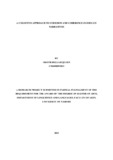| dc.description.abstract | This study investigates the cognitive approach to cohesion and coherence in Dholuo narratives. The objectives of the study were to determine how the cognitive principles – frames and profiles – could be used to analyse grammatical cohesion, lexical cohesion and coherence. Therefore this study applied Langacker‟s theory of cognitive grammar. It was hypothesised that frames and profiles could be used in the analysis of cohesion, and coherence could be analysed using frames. The study used the cognitive grammar approach in the analysis of cohesion and coherence in Dholuo oral narratives, since previous works done in this language have only followed a descriptive method of analysis proposed by Halliday and Hasan, without going into depth of how readers are able to maintain such links between different lexical items and interpret different sentences as creating a unified whole. For this research, eight written Dholuo oral narratives were selected from the book „Oral Literature of the Luo‟ by Okumba Miruka. The results showed that frames and profiles bore different insights compared to Halliday and Hasan‟s approach. These principles indicated how readers are able to establish the coherence of a text and interpret different lexical elements as being cohesive. It was seen that, lexical units evoke frames, which in turn consisted of frame elements that readers had access to and enabled them to establish how a text is cohesive or maintained coherence. Moreover, certain elements were profiled in these frames and readers could then link pronouns for example, to the profiled entity. The cognitive model illustrated how readers organised their knowledge of the world into these frames, which were then evoked each time a person wanted to make sense of what s/he reads. It was also found out that readers have access to a NARRATIVE FRAME, which stored the different information of the individual narratives and also certain conventional beliefs concerning narratives, for example, information concerning fictional narratives. Readers could therefore evoke this NARRATIVE FRAME, which would in turn enable them to arrive at the right interpretation of lexical items. The study therefore did achieve its objective and proved the hypotheses that the cognitive principles could indeed be used to analyse cohesion and coherence in the Dholuo narratives. | en_US |

